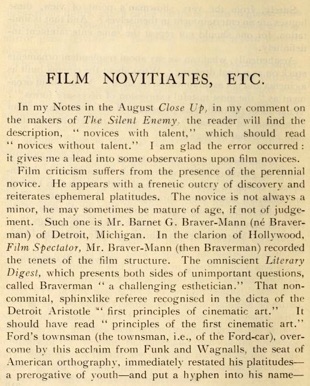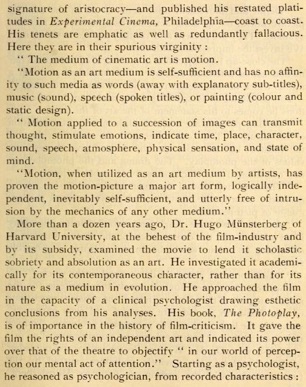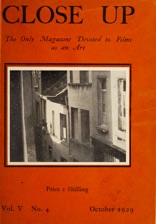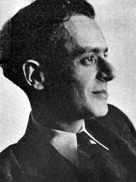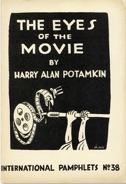City Lights 1930 1931 1932 next previous
City Lights Clippings 143/387
Harry Alan Potamkin, Close Up, Territet, Switzerland, Nov. 1930.
Harry Alan Potamkin, The Eyes of the Movie Cover,
International Pamphlets No. 38, New York, 1934
& Harry Alan Potamkin (portrait), in The Eyes of the Movie,
International Pamphlets No. 38, New York, 1934
& Cover with Ombres et lumières Scene
(...) Close Up, Oct. 1929
„The end Chaplin should have sought“
Editorial content. „FILM NOVITIATES, ETC.“ (...)
„Novitiate is cult. In the September Theatre Guild
Magazine, Braver-Mann discovers Charlie Chaplin. A long time
ago I began to prick the cult of Chaplin. I know that
others have questioned the absolute evaluation of him as
(to quote Max Reinhardt) ,the beginning and end of
cinema.‘ Bakshy in a brief note indicated Chaplin‘s inadequacy
as a director of his comedies. Seldes – one of the
inflaters of Charlot – like the weathercock he is, re-echoed
faintly (in a vague mention) Bakshy‘s doubt. Silka in the
Filmliga tijdschrift refused to sign to unqualified admiration
of Chaplin. Les Chroniques du Jour devoted a special
number to Chaplin, allowing some ,Nos‘ from Carco et al. I am
certainly not advocating muckraking – there is something
of that suggested by Hugh Castle‘s article. Any full study or critique
of Chaplin will not simply have to plough through the cultism
of Delluc, Poulaille, Iwan Goll (Chaplinade), the effete poets and
painters, Seldes, Stark Young, the Tribune Libre (which
had a Gala Chaplin, not succeeded – for the first time in its history
– by a discussion), etc.; but will estimate Chaplin socially,
as I have indicated in the following:
,Chaplin brought into the comedy the English music-hall,
whose manner has been his stamp since. But his development,
though it has been toward the more precise reference
of satire, has not been without the influence of Sennett and
Linder... Chaplin extended the comic type to a social
center-of-reference and achieved therewith satire – the humour
of society.‘ In this article New World Monthly, February,
-
1930)I went on to indicate the failure to extend the uses of
rhetoric in the movie comedy, and assigned as one
cause of the failure ,the cult of Chaplin.‘
,The emphasis upon Chaplin as the film‘s one full realisation
has obscured the origins of American film-comedy. It has
also not considered Chaplin‘s limitations as a director and the
shortcomings of the artist as performer. He has not yet
achieved a Don Quixote toward which his comedy tends but does
not attain...‘ In the August 29 issue of The New Freeman,
I attributed the frustration to several causes: the cultist stress,
Chaplin‘s own limitations and the suppression of the
creative social energies.
A current instance of this cultism is a child‘s story written
by Michael Gold, Charlie Chaplin‘s Parade, which never
asks whether Charlie Chaplin is an experience of the child of
today, if ever he were to the child for whom this book
is meant – the pre-adolescent. In my work with children I have
learned that Chaplin – subtilized and infrequent in his
appearances – is considered ,silly‘ by children in adolescence,
whereas Lloyd – or even the innocuous Bobby Vernon –
would be preferred. (Date, as of 1928.)
Braver-Mann goes typically into the Commedia dell‘ Arte
for Chaplin‘s ancestry with a show of the knowledge
of school books. Fred Karno is a more propinquitous forefather.
B-M says ,There is nothing stereotyped in the humour
of any Chaplin comedy...‘ Which is erroneous. Chaplin utilized
English stereotype; that was his first achievement: the
fitting into the movie progression of the intensive frame of English
vaudeville. B-M vindicates Chaplin‘s ,apparently
unmethodical manner‘ by entrusting it to ,feeling‘ (the quotes
are Braver-Mann‘s). Murnau expressed it much more
concisely and accurately when he spoke of the spontaneous
film of a Chaplin as a raconte. But even the fact of
Chaplin‘s being a raconteur, while it explains, does not excuse
his directorial failure. As a matter-of-fact, Braver-Mann‘s
attempt to validate the cult betrays Chaplin. His article is mainly
of Chaplin the single personality. The brief space devoted
to Chaplin the creator of the film and the rather quibbling criticism
of Chaplin‘s ,inability to think and work in terms of montage‘
reflect two things: Chaplin‘s directorial limitation, and Braver-Mann‘s
shirking of a major problem. Chaplin‘s success in A Woman
of Paris would seem to vindicate him as a director, but we must
not forget the arbitrary limitations Chaplin set himself.
The sustained interrelationship of characters was between two
personages only, and the ,visual continuity‘ did not
comprise extensive reference. Ideologically and in treatment,
the cinema will need to hold Chaplin (and Monta Bell?)
responsible for an insidious influence, Chaplin‘s inspirational
temperament could create entities in two-reels;
increasingly it has made what are but tableaux in his longer
films. Every good director allows for the flexibility of the
idea born ,on the lot.‘
I too do not deny Chaplin‘s eminence. But at this late date
it is cult-sycophancy to talk about such obvious Chaplin
traits as ,plasticity, imagination, and mastery of pantomime.‘
By the way, had Mr. Braver-Mann read an article of mine
– published several years ago in The Billboard – he might have
added the choreographic value of Chaplin‘s two-reelers.
The use of adjective like Rabelaisian (an ignorant though popular
use of that adjective incidentally) and Falstaffian do not
concern the Chaplin of today – why have not his longer films
been more than elongations of his shorter? And all of the
numerous descriptions of his type have been anticipated in ,the
classic hobo,‘ just as Harry Langdon has characterized
himself as ,a Christian innocent.‘ Braver-Mann has not dwelt
sufficiently upon Chaplin‘s fear of over-acting and his
penchant for good tastes: defects in a director... see D. W.
Griffith. No Chaplin film beyond two reels can compare
as a structure-in-comedy with Hands Up! No Chaplin film can
equal in the enactment of the comic spirit such a work
as Mark Twain‘s A Connecticut Yankee in King Arthur‘s Court.
And Chaplin promised to give us a film of social
quixotism, where his pathos would render the humor poignant
as a social indictment. He gave us The Circus, in which
the pathos seeped out until it trailed after the conclusion of the film. America depressed him, and his own quasi-intellectuality
hindered him. His book, My Trip Abroad, though prepared by Monta
Bell, explains much of Chaplin‘s impasse. When he resists
the sycophantic and ill-tutored Braver-Mann, the semi-esthete
of the Seldes ilk, the paternal metaphysic like Waldo
Frank – trapped in controversies with the soul, the populists,
the demagogues of letters, the specious enthusiasts,
all who would inflict their cult upon him, and listens to demands
which urge him to forgo spurious virtues, he may move
beyond his present status. Though I doubt that he can do so,
in the present mind of the movie.
The suggestion of muckraking in Castle‘s comments
on Chaplin is induced by the typical London playboy
tone. Yet Castle has put his finger on one of the ideological flaws
in Chaplin‘s work: ,the atmosphere of intellectual despair.‘
It is this pathetic defeatism, this cynicism (which, by the way,
in even more offensive forms is discoverable in Lubitsch)
that attracts middle-class intellectuals. Hands Up! was much
more heroic comedy. Castle, I believe, when his tone –
as on page 135 – becomes direct, didactic even, says much
more than Braver-Mann in a fraction of the space.
The simultaneity of these considerations of Chaplin points
to a crucial moment in Chaplin‘s career. Muckraking,
especially in America, will corrupt the sincere criticism of the man,
and equally unscrupulous defences will force a false issue.
Chaplin, not ever a secure personality in the American scene,
may be further confused. His enthusiasts have been
unfair to him: their outcries have been forms of self-expression
unmindful of the artist as a developing phenomenon.
Add to these the journeyman of the Tim Tully and Konrad
Bercovici type and you can have a sense of the sum
of pressures upon the mind of Chaplin. Chaplin‘s severest critic
(though his statement appear hypocritic) will be his best
friend. Six years ago Gilbert Seldes (The Seven Lively Arts) said
of Chaplin: ,He is on the top of the world, an exposed
position, and we are all sniping at him... It is because Chaplin
has had all there ever was of acclaim that he is now
surrounded by deserters.‘ Muckraking began early, but it has
not accumulated. The Seldeses of criticism will have
been responsible for much that will ensue. In their zeal to disprove
the effete Stark Youngs they are deflected from the intensive
consideration of what is most assertive in Chaplin. True it is there
is Sennett in Chaplin (I have said as much) and ironic
it is that one who has been called too ,literary‘ a film critic should
urge against Chaplin‘s becoming too literary. Actually
what I urge is that the Sennett presence should materialise
in scope and the Chaplin in pointedness. ,Irony and pity‘
comprise only a banal slogan: from Anatole France to Paul
Eldridge. I disagree with Seldes that Chaplin has
excelled in composition, or that the illusion of the impromptu
is a dominant virtue. The arabesque of rhetoric
articulating a conception of social experience is the end
Chaplin should have sought – and would have –
in a society where the Seldeses were muted and the critical
perceptions active. The populists have done Chaplin
dirt. They have made their sentimental and wistful pleasure
in his whimsicality stand for supremacy in appreciation.
Certainly Stark Young was wrong in seeing Chaplin as too much
theatre – Charlie re-converted his derivation – but that
the latter has not extended his tendency far enough along
the path toward fulfilment, was sadly perceivable
in the fatuous and dissociated pity of The Circus, and in the
foreshortened exposure of The Pilgrim.
Harry Alan Potamkin.“
Redaktioneller Inhalt
City Lights 1930 1931 1932 next previous

